March birding day trips in Madrid - observations
John Muddeman
10/03/2011 12:23:23
As well as the resident bird species, winter visitors and incoming migrants add to often surprisingly high diversity visible in Madrid, as shown during recent guided day tours.
Posted in: Flora, Butterflies and Moths, Birds, Mammals | Madrid | Mainland Spain, Central Spain
It’s often surprising what can be seen at this time of year, 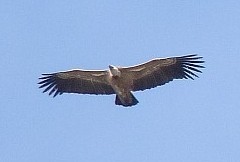 Griffon Vulture
Griffon Vulture
Gyps fulvus© John Muddeman but with the first Northern Wheatears and Sand Martins reaching the UK at this time, it’s no surprise that migrants are arriving in force into C Spain too. That said, this is not the warmer SW however, and living in the centre of the peninsula at the base of the Sierra de Guadarrama mountain range means it’s much colder than coastal areas, and so several weeks behind parts of Andalucía and Extremadura.
However, two day trips with relatively good weather have highlighted what’s happening with residents, winter visitors and early migrants and are worth commenting.
Sunday 6th March – N & NE of Madrid in agricultural, mountain and dehesa areas.
The target species for the day were principally Spanish Imperial Eagle (but all raptors were of particular interest), 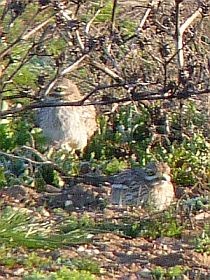 Eurasian Stone-curlews
Eurasian Stone-curlews
Burhinus oedicnemus© John MuddemanEurasian Stone-curlew, Black-bellied Sandgrouse, Little Bustard, Iberian (Azure-winged) Magpie and possible Black Wheatear and Eurasian Eagle-owl. However, the latter has apparently become scarcer in recent years and with poor weather during the whole week leading up to the trip (very chilly and windy at times, and snowy at others!) an attempt at locating a pair on the Saturday evening was not surprisingly unsuccessful. But the trip was also paced to go a little slower and try to see as much as possible as well as enjoying some of the fine countryside around Madrid.
Leaving central Madrid shortly after 7 a.m. were soon in a nearby river valley, and with temperatures dropping as the sun rose, the thick frost showed we would probably do better off elsewhere. A few Great Cormorants flew past, a Cetti’s Warbler sang from dense riverside cover where an Iberian Magpie put in a brief appearance and some Eurasian Tree Sparrows called, and a few Fallow Deer fed quietly on nearby slopes before soon moving off. Otherwise it was quiet though, so we quickly moved on.
Our first stop was in an agricultural area NE of the capital, which remains a patchwork of non-irrigated fallow and cultivated cereal grain fields, so maintaining populations of the steppic birds still present in the area. Indeed, as we stopped, the first of a notable flock of  Scenery including the Sierra de Guadarrama in Madrid© John MuddemanEurasian Stone-curlews were resting, typically immobile, in an adjacent field and close to the car. Parking nearby we then took a short walk into another field, and being before the local dog-walkers arrived were rewarded with fine views of the local singing Corn Buntings, a hunting male Hen Harrier, a slightly distant group of 18 Great Bustards, a fine Calandra Lark in display flight and two views of a flying male Little Bustard. An excellent start to the day! A chill breeze meant we were all too happy to get back into the vehicle for a short drive along nearby roads and tracks though, with Red-legged Partridges and Crested Larks of most note amongst a few other species present.
Scenery including the Sierra de Guadarrama in Madrid© John MuddemanEurasian Stone-curlews were resting, typically immobile, in an adjacent field and close to the car. Parking nearby we then took a short walk into another field, and being before the local dog-walkers arrived were rewarded with fine views of the local singing Corn Buntings, a hunting male Hen Harrier, a slightly distant group of 18 Great Bustards, a fine Calandra Lark in display flight and two views of a flying male Little Bustard. An excellent start to the day! A chill breeze meant we were all too happy to get back into the vehicle for a short drive along nearby roads and tracks though, with Red-legged Partridges and Crested Larks of most note amongst a few other species present.
Another, much longer track not far away took us through to late morning, including a couple of short walks, and after seeing a few very distant flying Black-bellied Sandgrouse we finally located a small group on the ground, albeit in marked heat haze given the still 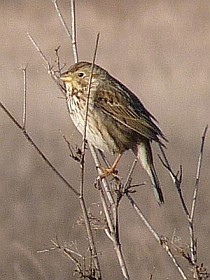 Corn Bunting
Corn Bunting
Emberiza calandra© John Muddemanchilly air but a strong sun warming the ground. However, another pair flew close past, their lovely bubbling call just audible to us as they went and gave fine views both in the air and then again on the ground once they’d pitched into some fallow.
The raptors also finally started to move, with a very distant displaying harrier presumably another Hen Harrier, several Red and a single Black Kite drifting around, and the first Griffon and Eurasian Black Vultures cruising past. A few butterflies were also moving, including a Small Copper and various Western Dappled Whites. A good mixed-species flock of finches and sparrows in a nearby field contained a few Rock Sparrows, though a calling Brambling which was passing over also dropped in to feed, much to my surprise (and delight). Singing Crested Larks were singing all around, though a slightly different song revealed a fine Thekla Lark displaying right overhead, with its grey underwings easily seen.
Driving north we were just discussing about Short-toed Eagles when one, complete with a snake’s tail hanging from its bill, drifted over escorted by two Carrion Crows. This coincided with a ‘mass’ arrival of this migrant species here, given several other records by other observers around C Madrid the same day.
Our next site was on the edge of the mountains proper, at a small gorge. However, being Sunday it is a favourite with day trippers from Madrid and so despite still being good for birds, including a 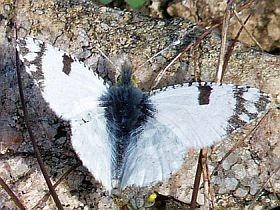 Male Western Dappled White
Male Western Dappled White
Euchloe crameri© John MuddemanCrag Martin, four Red-billed Choughs, various passing raptors including a brief Golden Eagle and singing Rock and Cirl Buntings, the Blue Rock Thrushes proved too elusive to see other than in flight and the wheatear was sadly absent again too. Perhaps the recently installed wire netting covering a significant part of the rock faces has put them off and I need to look for an alternative site nearby. So we relaxed at a small bar, watching a few birds passing over -including a Hawfinch-, took a very early snack lunch, including the spiciest patatas bravas I’ve ever eaten in Spain, and after ordering a few filled rolls for later, moved on again.
A roadside stop near a large rubbish tip (!) was excellent, with the air filled with thousands of Lesser Black-backed and Black-headed Gulls as well as a few Eurasian Black and Griffon Vultures, plenty of Red and a few Black Kites and dozens of White Storks. Nearby bushes also held a few Spanish Sparrows and Common Stonechats for variety.
With time running away we finished up eating our rolls at 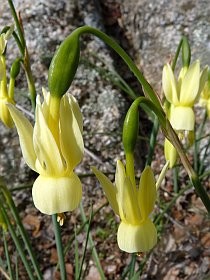 Angel's Tears
Angel's Tears
Narcissus triandrus© John Muddemana viewpoint ‘lost’ in the hills looking down to N Madrid. Despite several Thekla and Woodlarks en route, most of the time was spent looking for raptors, and among the vultures and a few Common Buzzards, we soon saw a fine adult Spanish Imperial Eagle in flight. Losing it later, we then found a high passing Black Stork instead, but eventually located a pair of perched Spanish Imperial Eagles below us, which despite being distant, were good enough the clear conditions to see the straw-coloured head shawl and white patch on the bend of the closed wing. A further surprise – given the slightly late date and late hour – were two flocks of Common Cranes going noisily and high over on passage, undoubtedly on their way to the stop-over site of the Laguna de Gallocanta. As we departed a few charming flowers of Angel’s Tears Narcissus triandrus timidly appeared in the shelter of a boulder, and a few butterflies also included a Small Heath Coenonympha pamphilus.
We returned to Madrid, adding three Monk Parakeets to the list as we returned to the hotel, among an excellent total of 77 bird species during the course of the day.
Tuesday 8th March N & NE of Madrid in agricultural, mountain and dehesa areas.
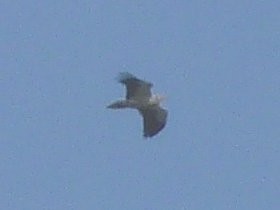 Testimonial photo of an adult Egyptian Vulture
Testimonial photo of an adult Egyptian Vulture
Neophron percnopterus© John MuddemanTaking an almost identical route to two days before, this time the list of hoped-for species was far larger, and despite slightly cloudier and cooler weather in often dead-still conditions, we ended up seeing more.
Starting in E Madrid, this time we headed straight to the agricultural area first, with a large flock of Corn Buntings also containing few Spanish Sparrows amongst others, and the Eurasian Stone-curlews, male Little Bustard, Red-legged Partridges and Crested Larks all reappeared too, as well as several wintering Meadow Pipits and Eurasian Skylarks.
The longer track nearby again produced a fine haul too, including perched Common Buzzards, hunting Eurasian Kestrels, a singing Cetti’s Warbler, a total of 41 Great Bustards, a male Black-bellied Sandgrouse, a ‘pair’ of Merlins, several Rock Sparrows, a female Brambling and a fine male Black Redstart amongst others.
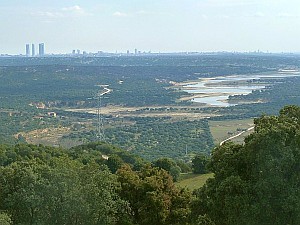 Northern Madrid and El Pardo reservoir© John MuddemanThe gorge to the N was also excellent, though a group of well over a 100 Rock Sparrows on roadside wires combined with two passing Griffon Vultures and a hunting Eurasian Sparrowhawk naturally seeing us stop en route for a few minutes! This time we opted for walking the bottom of the gorge, keeping an eye out for any passing raptors, and within minutes were rewarded with an adult Egyptian Vulture cruising past. These are ever scarcer migrants (with none breeding) in Madrid and this was my first! A male Sardinian Warbler showed well, European Serins, European Robins and Common Chiffchaffs all showed well too, and a pair of Rock Buntings then put in a fine display.
Northern Madrid and El Pardo reservoir© John MuddemanThe gorge to the N was also excellent, though a group of well over a 100 Rock Sparrows on roadside wires combined with two passing Griffon Vultures and a hunting Eurasian Sparrowhawk naturally seeing us stop en route for a few minutes! This time we opted for walking the bottom of the gorge, keeping an eye out for any passing raptors, and within minutes were rewarded with an adult Egyptian Vulture cruising past. These are ever scarcer migrants (with none breeding) in Madrid and this was my first! A male Sardinian Warbler showed well, European Serins, European Robins and Common Chiffchaffs all showed well too, and a pair of Rock Buntings then put in a fine display.
The nearby slopes usually require a bit of walking to get the best from them, but no sooner were we out of the car than a Thekla Lark sat on a Prickly Juniper, and underneath it a male Dartford Warbler appeared and then reappeared several times as it fed on and very close to the ground for several minutes. Superb!
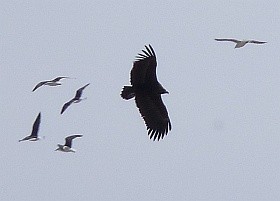 Black Vulture and Lesser Black-backed Gulls
Black Vulture and Lesser Black-backed Gulls
Aegypius monachus + Larus fuscus© John MuddemanThe hordes weren’t present this time, so we enjoyed a couple of the local dishes while sat outside watching passing raptors, though a superb Hawfinch in a poplar (following another we’d seen in an orchard), and two passing Golden Eagles kept us busy too! Dense cloud was looming threateningly though, so we moved on again towards a wild area N of Madrid, stopping beside the tip for the same mixture of birds as before, though Black Vultures were sadly absent this time. Just after we left though, a stop for an Iberian Grey Shrike Lanius meridionalis, which showed excellently in the scope also saw us see two Spanish Imperial Eagles among the melee of birds wheeling over the tip, and then one of these as it stooped on a Red Kite, which then dropped its food, which was then deftly caught in mid-air but the eagle before being carried off and presumably eaten in comfort somewhere quiet nearby!
We next stopped on a long access track in a remarkably wild area N of Madrid for a calling Firecrest. This quickly revealed a remarkably large flock of them, though they were incredibly furtive and flighty and indeed the best view we had was actually of an unexpected lone Goldcrest among them! Calling Crested Tit and singing Cirl Bunting refused to show however, and when it was clear that in the chilly, dull and still conditions that the distant perched Spanish 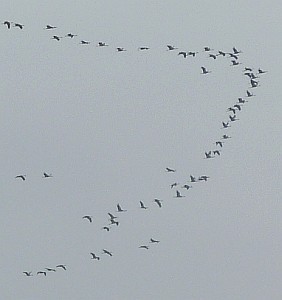 Part of a flock of migrating Common Cranes
Part of a flock of migrating Common Cranes
Grus grus© John MuddemanImperial Eagle adult wasn’t likely to move, we headed to edge of Madrid itself!
We were now running out of time, but a large flock of birds moving low towards us required pulling off into the first place possible, and from here we had good views of almost 130 Common Cranes coming low past on passage.
Another wooded area and river quickly yielded sightings of several more wanted species, including Short-toed Treecreeper, Crested Tit and Grey Wagtail, though a calling Common Kingfisher sped past underneath without being seen. Our final stop was now in very dull, chilly and still conditions, with almost nothing moving except a small flock of Barn Swallows and House Martins hunting for insects over the river, but then, to our enormous surprise, almost the last bird was saw was a swift! March swifts in Madrid are very uncommon, but of course, this was a Pallid, which typically arrives back much earlier than Common, and we could even appreciate its relatively blunt wingtips as it passed overhead before cruising in leisurely manner off towards the capital. A really terrific end to a great day, with some 85 species seen in total and several notable records of early spring and later winter migrants in the process!
Read more blog posts